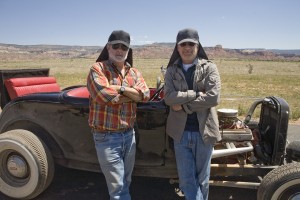Kerner Optical was once again called upon to contribute a stunning array of miniature models to destroy for the fourth installment of the epic film series. We spoke to Brian Gernand, model/miniature supervisor for Kerner Optical about the film. Kerner is the former ILM model shop, directly responsible for so many of the stunning visuals that made the first three Indiana films one of the most loved film franchises in history.
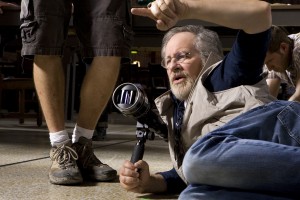
Brian Gernand, model/miniature supervisor for Kerner Optical. He worked very closely with Indiana Jones’ visual effects supervisor Pablo Helman, a native of Buenos Aires who joined Industrial Light & Magic in 1996 as the Sabre Department Supervisor. Today is one of the most established and sought after vfx supervisors. He lead the team in working out what was to be digital, what was to be done in miniatures and then how all the elements would then be combined at ILM.
Kerner Optical contributed to many aspects of the film but three of their largest individual miniatures sequences, namely were the destruction of Doom Town by a nuclear bomb test, the remote Peru Pyramid and the end sequence of the Aktor dam break.
Dam break
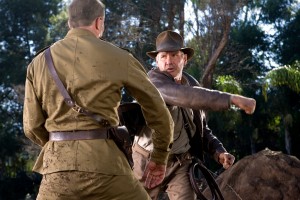
In the final Aktor dam break, Helman’s solution was to combine a large scale miniature with a live action water spill tank, and digital water from ILM. This is a similar approach to the one used by the two companies on both the Pirates films and Evan Almighty.
The water that rushes through the gaping holes in the mesa rock wall in the shot was from the Kerner spill tank, shot at 1/24th scale (roughly). Kerner built a set with rock walls holding back some 32,000 gallons of water in dump tanks. The door on the dump tanks could be dropped almost instantly. The weight and pressure of the water combined with the design of the miniature allowed the water to dramatically and believably burst out. There were four different walls in total made of organic material, ranging up to 10 feet in the air and 15 to 30 feet wide.
Once the walls hit the back of the set, they were crumpled and shot into the set as debris, cascading the rock onto the ground and allowing the water to rush out. Kerner created baffles to break up the water and make it appear extremely turbulent and violent, as if the water was moving in at a really fast pace. Water sprays and elements were also turned over to ILM, who used them in the composite until the point where scale became an issue, at which time ILM created water simulations or water effects.
“The thing about water is a drop of water is a drop of water, unless you can explode it somehow or atomize it or break it up to give the proper scale. That is something we try really hard to do.”
The water sequence was shot at about 60 frames per sec., over a period of several days. Although Kerner Optical worked on an approximate scale (1/24th) for the water, this was not an exact science. Without reference scale, it is very difficult to judge accurate waterfall proportions. In fact, Helman showed Kerner real photographs of waterfalls he had shot and everyone agreed that the scale was very hard to determine. They decided then to focus on things like atomizing the water and less on exact scale issues.
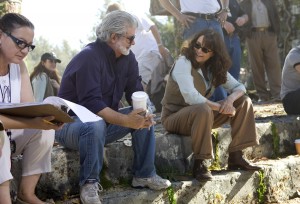
This sequence was filmed in the middle of winter. The Masa wall was a combination of cement, dirt and 200 to 300 cubic yards of vermiculite. Vermiculite is a natural mineral that expands with the application of heat. “It pops like popcorn,” explains Gernand. The expansion process is called exfoliation and is routinely accomplished in purpose-designed commercial furnaces. Vermiculite is formed by hydration of certain basaltic minerals. “It expands to 10 times its original size and yet it remains the same weight. Kerner uses vermiculite from China processed in Northern California’s East Bay. It comes in 5 cubic yard bags for aerating soil and Kerner Optical uses it to reduce the weight of the actual dirt while keeping it organic.
The dam walls were constructed lying down, so that they could be crafted and painted properly. Once built they were taken outside, lifted with a crane ten feet into the air and correctly positioned next to the dump tanks. Without the vermiculite, the material would not break apart in a natural way. “It needed to look natural, like mud,” Gernand explains. To ensure the correct breakage of the Mesa wall it was also laced with prima cord, a controlled explosive which burns at a rate of 20,000 feet per second. Prima cord usually requires a cap to ignite it.
The dump tank set was set up and shot outside on the famous Kerner “slab”. To maximize realism it was backlit with natural sunlight during magic hour, while the set itself remained in natural shadow. This may seem dramatic, but the truth is that miniatures typically require a large amount of light to provide enough depth of field. The Kerner Optical team shot using high speed stock yet still found holding depth of field to be tricky. Given the requirement of sun setting magic hour daylight in the middle of winter, the window in the day of ‘good’ light was very narrow. The team had to manage to film at exactly the right time or miss their opportunity. Testing was done prior to the big day but Gernand credits both the excellent judgement and experience of Kerner Optical’s DOP Marty Rosenberg and the skill of Pablo Herman in successfully managing and capturing the shot in such conditions.
Doom Town
For all its vast history of exploding buildings and towns, this was the first time that Kerner Optical (or ILM Model Shop) has undertaken the full scale nuclear explosion of a town. Although one was initially scheduled for the original Back to the Future movie, it was only until now that Kerner Optical got to nuke a city. Of all the sequences in the new film, this one of the only one that audiences already knew from real historical footage. Most people have seen old military test footage, unlike some of sequences, the audience had very real expectations of what a test nuclear blast would look like.
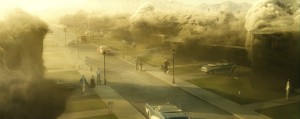
This project was extremely challenging for the team. Lucasfilm sent Kerner close up shots of real buildings being blasted in real nuclear tests from the 1950s. Gernand comments “it was remarkable, there were many waves to the event,” . The first was the heat wave that burned the paint off the building. On close examination it looks almost unnatural, as if the film is going backwards, right before the shock wave hits. And when the shock wave finally does hit, it is simply as if the thing is hit with an air canon. Buildings in a real blast cave in, and then a building is hit by a shock wave and literally all the debris goes horizontal to the field of view. Nothing really goes up. For us to generate that kind of energy and that kind of air movement without the debris moving upward was really challenging.”
While it might have been considered to shoot the set vertically, the 60 square foot set was shot flat. The vast set was rigged with over 15 hundred-gallon air canons. The way they were rigged was to have a set off camera, and then a second set under the deck with nozzles coming up inside the first row of houses at a 90 degree angle. Then each house was laced with prima cord. The whole rig was computer rigged to fire with split second precision.
There were two primary shots in Doom Town and the timing was critical in both. In the first one, for example, the blast is coming towards the camera from down the street so everything cannot fire at once, or the viewers point of view would be obscured. Gernand recalls, “In that shot the air canons are firing “boom, boom, boom,.. coming at the camera, but just before the canon goes off, actually the prima cord fires and creates that shock moment in the building where it becomes unglued – like an egg exploding in space – and then the energy from the 100 gallon air canon hits it and boom.. knocks it and sends all that debris we’ve created towards the camera.” In addition, some houses had mortars that blasted aluminum oxide. “It was almost like a shot gun inside the house that would allow the houses to have the exploded look.”
The buildings were constructed with very accurate scale, very delicately. They were actually built quite like a real building, they were stick frame constructed just like a real house, with scale studs, and milled sidings with pre scoring so they would break apart correctly. “We really wanted it to explode – and that was all based on that footage we had been sent by Steven (Spielberg),” explains Gernand. In addition to the construction, individual shingles were made for the roof and all the tiny windows were made of real glass.
In terms of the debris and destroyed material, “subtlety was everything: one pinch of dust was not enough, two was too much. Many materials had to be tested, and very precise dirt mixes were used. For example, something like fuller’s earth would have been too much.” Fullers earth is often used in special effects when simulating explosions. Fine-grained fuller’s earth makes a much larger plume than ordinary dirt, suggesting a larger explosion and allowing a smaller, safer charge to be used. Additionally, it can be used to artificially age costumes.
The actual props were handmade. The houses were built to come apart on cue, but inside the houses had shelves with pre-burnt, pre-melted debris. The houses were loaded with “completely destroyed furniture, matted curtains, literally in mounds everything that you would have destroyed.” Most houses were just two-sided, but loaded with enough mass of debris that the audience would believe a whole house was being demolished. On the roads surrounding the houses were mannequins, cars, and other items. Kerner built individual pedal carts, bicycles, lamp posts, and of course gardens around each house. These models were all 1/8th scale.
15 to 18 people worked on the Doom Town shots at various times, depending upon their speciality. For example, the cars in Doom Town were individually made. There were a couple dozen vintage handmade cars, all sculpted out of form and then vacuum-moulded over. In vacuum moulding, a sheet of plastic is heated to a forming temperature, stretched onto a single-surface mold, and held against the mold by applying a vacuum between the mold surface and the sheet. The vacuum forming process is very common in product packaging, and is usually restricted to forming plastic parts that are rather shallow in depth. It took the entire team almost 12 weeks to build the set.
The close-up shots of the mannequins melting were done digitally at ILM, but the live action set mannequins were at
Kerner Optical so exact copies could be made for the 1/8th blast.
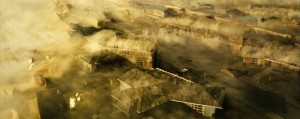
The explosion was shot by multiple cameras, ranging from 120 fps (not used in the film) to 60 fps and 80 fps. Kerner Optical delivered at least three or four camera angles, more than were pre-vized – just to provide editorial coverage. The explosions again took place outside on a deck in the natural sunlight. The decks started being built three weeks before the explosion with great care to map where the sun would be three weeks hence.
Since the explosion had to be backlit, it ended up that there was only a 10 minute window when the sun would be just right. “This meant that we had to go at exactly 3:35pm – we had only a 10 minute window of when we could do this – without cloud cover,” says Gernand. “Those were very stressful days, and there was a lot of very careful planning (mainly a lot of theory) as we could not test on a full scale level. All our plans and designs were going to be put to the test in front of the cameras without the chance of a second take” he adds. With an explosion of this size, not only were there privacy screens (for film confidentially), but they also had a need to stop traffic in the streets nearby, plus inform the local neighbors that there was going to be huge explosion.
There was only a week separating the second Doom Town shot from the first one. Time was quite critical as the schedule allowed only so much time between both massive set-ups and shoots. The second Doom Town explosion took another week to build and reset for the second camera angle.
After the explosion, the team moved on to the Dam break shot but even as the Doom Town set-up was being destroyed, Kerner Optical still did not know how the final dam scene would play out, or what exactly would be required to do so! It was another 8 weeks after the Doom Town setups before the dam photography began.
Peru Pyramid
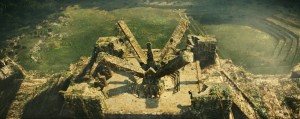
The Pyramid was made to match exactly the real sets that were built, for example, there was a very specific scale of stone which had certain amounts of vines and greenery. The team got art direction to build a 4 ft. model of the set, and combined this with some simple ILM computer models. Kerner set to building a 1/24th scale large miniature.
How the Pyramid was built:
- The pyramid itself was hand carved out of form.
- Using some laser cut templates for the stone layout, the team then used a tiny sand blaster to give the actual relief on the form,
- After that the lines were all cleaned up,
- The model was sealed,
- Then it was painted,
- And then the top live action section was matched.
- Finally, organic vines and moss were painstakingly laid over the pyramid to match a design that the team had agreed on.
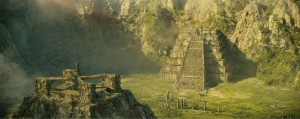
The model was built not unlike a matte painting, as it was never intended for the camera to be close up to the model. “It was important for me” says Gernand ” to encourage the model makers, if they worked on an area for an hour or two to step say 20 steps away and examine how it looks, as it had to work and be graphically judged from that distance, rather than looking fabulous from up close.”
With all this painstaking work taking weeks to create and yet destroyed sometimes in just a matter of seconds, we asked Brian Gernand if he ever wants not to push the go button and avoid seeing a set explode or be destroyed. His response:
“People have said to me ‘isn’t it a shame we have to destroy this’ but I have to be honest. The process, for me, is all about that moment in time on film and when I am looking at the set in its completely pristine hero condition right before it’s destroyed, my critical eye is looking for that thing that would be a scale buster. It is just all business, we look at it and say ‘that is looking good, this isn’t – this car in the foreground doesn’t look real, swap that for this, that lamp post isn’t perfectly straight, I want to change this grouping… ‘. It’s all about a visual composition for me, it has to all work together as an environment and match the live action. How it will break apart and in what order, what will do what when- especially with something like Doom Town where we only had one chance, the tension is high and we are constantly checking and adjusting to make sure it all goes off perfectly.”
